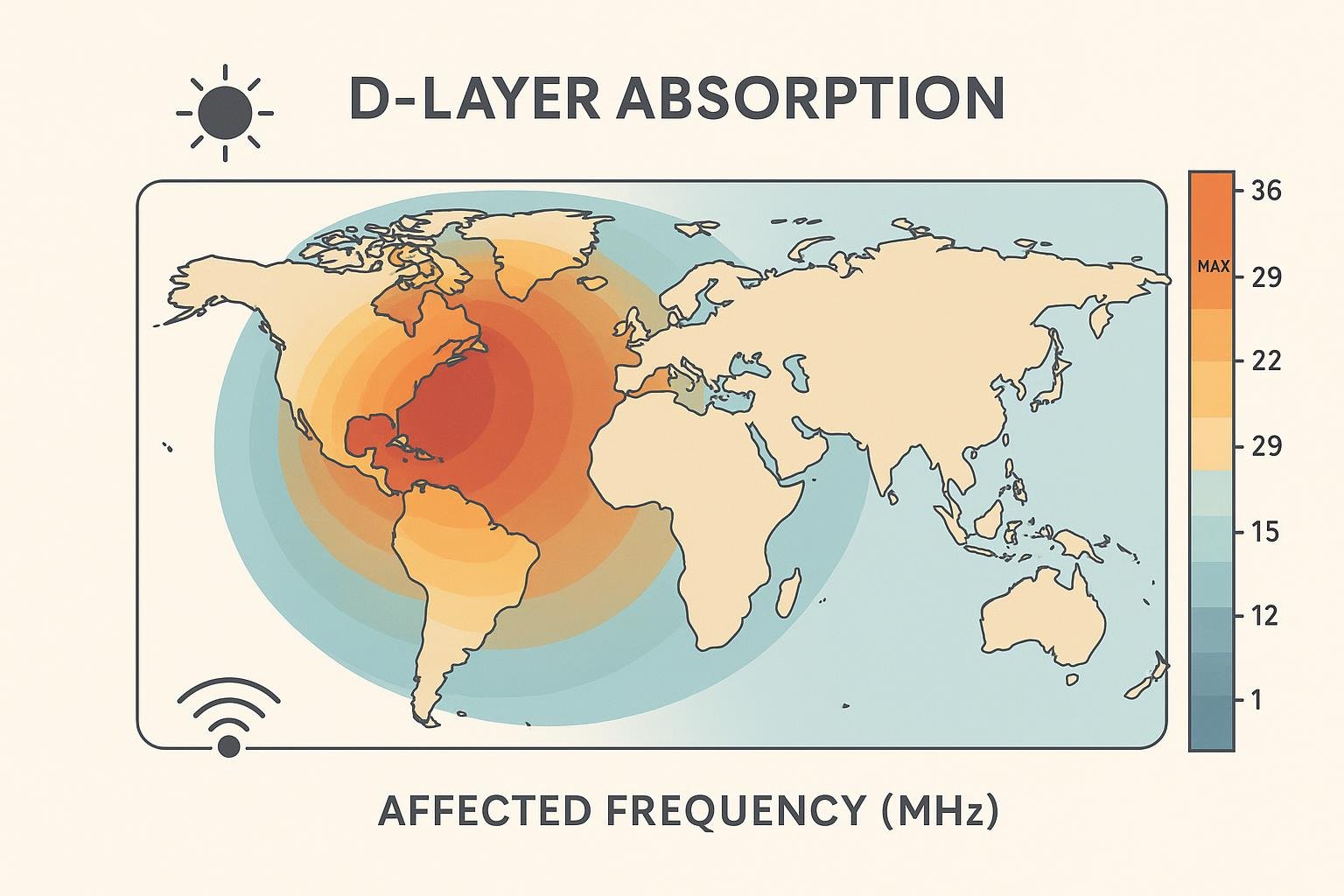How Does D Layer Absorption Impact Ham Radio Operators in Canada?
When operating ham radio in Canada, it's crucial to understand how the ionosphere, especially the D layer, affects your signals during different times of day and solar activity. D layer absorption during daylight causes significant attenuation of high-frequency (HF) radio waves, especially on lower bands, often limiting your ability to make long-distance contacts until the sun sets or solar activity decreases. This effect means adjusting your frequencies and expectations as conditions change.
The challenges from D layer absorption are not unique to Canadian operators. Still, given the country's broad geography and high latitude, you may notice that seasonal shifts, daylight hours, and periods of increased solar activity can have a larger impact here compared to other regions. Knowing what to expect from the D layer maximizes your operating time and helps you plan around daily absorption challenges, increasing your chances of reliable contacts. You'll see how predictive tools and practical experience combine to improve your success rate when you understand this essential aspect of HF propagation. For deeper insight into ionospheric effects, the amateur radio community often engages with recent research and modelling discussed in resources like the Heliophysics and Amateur Radio overview.
Key Takeaways
- D layer absorption reduces HF signal strength during daylight hours.
- You must adapt your frequency choices based on daily and seasonal changes.
- Understanding D layer effects lets you increase operating success across Canada.
Fundamentals of D Layer Absorption
Understanding D layer absorption is critical for reliable ham radio communications in Canada. The D layer forms the lowest region of the ionosphere, playing a key role in the absorption of radio waves and affecting HF signal strength and range.
Formation of the D Layer in the Ionosphere
The D layer is located roughly between 60 and 90 km above the Earth's surface, forming part of the lower ionosphere. It is created when solar ultraviolet (UV) and X-ray radiation strike atmospheric molecules, ionizing them and releasing free electrons.
This ionization primarily involves nitrogen and oxygen molecules. The process is most intense when the Sun is above the horizon, so the D layer is well-developed during daylight hours. Increased solar activity, such as solar flares, can temporarily boost D layer ionization, leading to sudden and significant changes in radio wave absorption.
For ham radio operators, the strength and presence of the D layer directly influence their daily operating schedules and expected HF propagation.
Daytime and Nighttime Behaviour of the D Layer
The D layer almost disappears at night because solar UV and X-ray radiation are absent, leading to recombination of electrons and ions. During the day, the layer acts as a lossy medium for HF radio waves, especially those below 10 MHz, causing notable signal attenuation.
In practical terms, daytime absorption can limit your ability to make long-distance HF contacts on lower frequencies. At night, with the D layer gone, signals at frequencies like 80 metres (3.5 MHz) and 40 metres (7 MHz) can travel much farther due to lower absorption.
Canadian operators in northern regions can experience different D layer behaviour in winter, when low solar angles mean less ionization even during the day, extending nighttime-like conditions for HF propagation.
Electron Density and Molecular Collisions
Electron density in the D layer is much lower compared to higher ionosphere regions, but its dense neutral atmosphere leads to frequent collisions between electrons and neutral molecules. These collisions mainly cause radio wave absorption, especially for lower HF frequencies.
The absorption level rises as electron density increases, essentially a function of solar angle and activity. The process can be summarized as:
| Factor | Effect on D Layer Absorption |
|---|---|
| Higher electron density | More collisions, greater absorption |
| Increased solar activity | Higher electron density, stronger absorption |
| Lower solar angles/night | Lower electron density, reduced absorption |
This explains why your signal strength drops during the day and improves at night, and why sudden solar events can produce abrupt changes in HF radio propagation. More details on electron density effects on amateur radio can be found in dedicated ionospheric research articles.

Radio Wave Propagation Through the D Layer
Ionospheric conditions influence radio wave propagation through the D layer, radio frequency used, and atmospheric chemistry at 60–90 km altitudes. Daily and space weather-driven changes in the D layer can reshape communication reliability for ham radio operators in Canada.
Frequency Dependence of D Layer Absorption
Absorption in the D layer strongly depends on frequency. Lower frequencies, especially those below about 10 MHz, are more affected because they interact more with the dense neutral particles and free electrons in this region. This interaction transforms a portion of your signal's energy into heat, causing noticeable signal loss.
The higher the frequency, the less absorption occurs as the signal travels through the D layer. For amateur (ham) radio, bands such as 80 and 40 metres experience much heavier absorption, particularly in daylight hours when the D layer is more ionized. Absorption becomes minimal for frequencies above 15 MHz under average conditions.
Impact on Lower and Higher Frequency Bands
The D layer's daytime ionization means lower HF bands (3–10 MHz) suffer significant attenuation from sunrise to sunset. This reduces your transmission range and can sometimes cause complete signal fade-out, known as "shortwave fadeout," during intense solar events. Night-time brings relief, as the D layer weakens and these bands become more usable.
In contrast, higher frequency bands (above 14 MHz) penetrate the D layer more efficiently and maintain reliable propagation even during daylight. However, even these higher bands can experience increased absorption during periods of intense solar activity, limiting your communication options. Knowing when to switch bands is essential for maintaining connections across Canada.
Attenuation Effects for Ham Radio Signals
For Canadian ham operators, attenuation from the D layer means a reduction in signal strength, particularly on HF frequencies. You’ll see more dropouts and fading during periods of high D layer absorption, especially in the auroral zone and during geomagnetic storms. Effective communication may require increased power, antenna adjustments, or frequency changes.
Severe solar events, such as X-class flares, can cause strong D layer ionization, resulting in HF radio blackouts over large regions. A detailed study of HF radio propagation across Canada showed that these disruptions can last minutes to hours, affecting safety and operational networks relying on ham radio for remote communications. Regular monitoring of solar activity is crucial for anticipating severe attenuation events.
Consequences for Canadian Ham Radio Operators
D layer absorption on the HF bands impacts how and when you can reliably make contacts across Canada. Solar radiation, season, and latitude majorly determine radio propagation on 160m, 80m, and 40m.
Daytime Limitations on 160m, 80m, and 40m Bands
During daylight hours, the D layer in the ionosphere is heavily ionized by solar radiation. This causes strong absorption of lower HF frequencies, particularly on the 160m (1.8 MHz), 80m (3.5 MHz), and 40m (7 MHz) bands.
As a result, you will find that local and regional contacts are much more difficult on these bands until the sun sets. This effect is pronounced in southern Canada, where higher population centres are clustered. Expect increased static and weaker signals, making daytime operations on these bands challenging for both voice and digital modes.
The impact is not the same for all frequencies—lower frequencies like 160m are absorbed the most. The table below shows the typical daytime D layer absorption effect:
| Band | Daytime Absorption Effect |
|---|---|
| 160m (1.8 MHz) | Very High |
| 80m (3.5 MHz) | High |
| 40m (7 MHz) | Moderate |
This leads many Canadian ham radio operators to use higher frequencies or VHF/UHF modes when the sun is up.
Nighttime Improvements and Long-Distance Contacts
At night, the D layer dissipates as solar radiation vanishes. This allows the lower HF bands (160m, 80m, 40m) to become much more usable across Canada.
You can expect signal strengths to rise and static levels to drop, enabling more reliable regional and cross-province communications. The lack of D layer absorption often allows for "DX" or long-distance contacts, sometimes reaching across the country or internationally.
Nighttime offers a significant advantage for emergency communications by providing greater coverage and versatility for amateur radio. Participation in contests and nets on these bands usually increases sharply after dusk, reflecting the improved propagation conditions. Many Canadian operators rely on local nets and traffic systems facilitated by these nighttime openings.
Seasonal and Geographical Factors in Canada
Seasonal changes alter the D layer absorption due to shifting amounts of sunlight. In winter, when days are shorter, you benefit from longer nighttime propagation windows on the low bands. Summer brings shorter nights and more prolonged daytime absorption, making night operation particularly valuable in northern regions.
Geography also plays a central role. Higher latitudes experience more pronounced D layer effects during periods of high solar activity. Northern communities are especially sensitive to these changes, as are operators in areas frequently impacted by auroral activity or solar flares, which further affect absorption and hamper HF performance.
In summary, your location and time of year in Canada can mean the difference between clear contacts and complete radio silence on the lower bands. Monitoring the ionospheric conditions and adjusting operating schedules are essential practices for Canadian amateur radio operators. For further reading on amateur radio and ionospheric impacts, refer to this article on heliophysics and amateur radio.
Relationship With Other Layers of the Ionosphere
Different ionosphere layers directly shape how your signals travel and where they can reach. Understanding how the E and F layers interact with the D layer—including their effect on daytime and long-distance propagation—is critical for making reliable contacts across Canada and beyond.
Role of the E Layer in Daytime Propagation
During daylight hours, the E layer sits above the D layer, reflecting medium-frequency radio waves to Earth. However, because the D layer absorbs lower frequencies, your HF communications below about 10 MHz are often limited while the sun is up.
Key impacts on ham operations:
- If you operate on 80 or 40 metres during the day, E layer reflection is possible, but D layer absorption often prevents your signal from reaching the E layer in the first place.
- As you move to higher frequencies, the E layer can effectively reflect signals, especially around the 15–20 MHz range, provided they penetrate the D layer.
The E layer also occasionally produces "sporadic E" events, enhancing propagation across medium distances. For Canadian operators, these events can bridge gaps within the country, particularly during summer. While the E layer can support daytime ionospheric propagation, D layer absorption sets practical limits on lower bands until sunset.
F Layer as a Pathway for DX Communication
The F layer is the highest ionospheric region relevant to amateur radio. It is essential for long-distance, or DX, HF contacts, reflecting signals over thousands of kilometres.
The D layer dissipates at night, and your lower frequency signals can pass unimpeded to the F layer. This enables transcontinental paths and global contacts—even on the 80 and 40 metre bands. During the day, higher frequencies (above about 14 MHz) can penetrate the D layer and be refracted by the F layer for intercontinental reach.
The F layer's ionization is strongest around solar maximum periods, extending your communication range further. Because of Canada's north-south extent, you may notice more variation in F layer performance compared to equatorial regions, especially during auroral events. This means your ability to achieve distant contacts on HF bands depends on both D layer absorption and the condition of the F layer above it.
The Influence of Solar Activity and Sunspots
Solar activity and the presence of sunspots directly affect the Earth's ionosphere, changing the behaviour of the D layer and the quality of ham radio signals. These changes can alter radio propagation and increase your challenges, especially at high frequencies.
Variation of D Layer Absorption During Solar Cycles
The D layer of the ionosphere absorbs radio waves, and its absorption properties fluctuate with the 11-year solar cycle. During periods of high solar activity, increased ultraviolet and X-ray emissions from the Sun intensify ionization in the D layer. This results in greater absorption of radio signals, particularly those in the HF (high frequency) range.
You may notice that daytime signal loss becomes more pronounced during solar maximum. In Canada, these changes can shorten your communications range, requiring you to adjust frequencies or operating times. Conversely, during solar minimum, D layer absorption decreases, often allowing for improved radio propagation and longer-distance HF contacts.
For a detailed review of how solar cycles affect telecommunications through ionospheric changes, see this discussion on solar radiation's effects on telecommunications.
Sunspot Impacts on HF Propagation in Canada
Sunspots are visible markers of solar activity, and their number correlates with increased solar radiation and enhanced D layer ionisation. When sunspot numbers are high in Canadian regions, the D layer absorbs more HF radio energy, which can cause noticeable signal fading or even complete absorption, especially on lower HF bands during daylight.
The table below highlights the relationship between sunspot activity and typical HF propagation effects in Canada:
| Sunspot Level | D Layer Absorption | Common HF Bands Affected | Daytime Range Impact |
|---|---|---|---|
| High | High | 80m, 40m | Reduced, more blackout |
| Low | Low | 80m, 40m | Extended, more reliable |
Sunspot peaks may lead you to experience increased disruption or attenuation on lower bands, forcing a shift to higher frequencies or nighttime operations. Research shows that sunspot and flare activity can trigger short-term spikes in D layer absorption, complicating HF contacts even further. For more insights on sunspot-related impacts on the ionosphere and radio in Canada, refer to this analysis of solar and geomagnetic activity.
Propagation Tools and Practical Guidance
Effective ham radio operation in Canada relies on up-to-date propagation prediction tools and understanding the effects of ionospheric layers, especially the D layer. Leveraging accurate resources and interpreting key metrics like MUF can significantly improve your on-air results and reduce signal loss from ionospheric absorption.
Using Propagation Prediction Resources in Canada
You have access to several dedicated propagation prediction tools tailored for Canadian conditions. Online platforms such as VOACAP Online, DXMAPS, and region-specific resources provided by Natural Resources Canada offer real-time and forecast data.
These tools account for the current solar activity, time of day, and your location in the country. They display changing conditions in the D layer, which can increase absorption on lower-frequency HF bands during daytime hours.
Consider setting up alerts for solar or geomagnetic events, often resulting in drastic short-term changes in HF signal absorption and noise. For best results, combine several tools to get a fuller picture of current and expected propagation conditions when planning your contacts.
Understanding and Applying MUF for Effective Communication
The maximum usable frequency (MUF) defines the upper limit at which ionospheric propagation is possible between two points. Maintaining your transmissions just below the MUF helps maximize range while reducing losses due to D-layer absorption.
To estimate MUF, use data from online charts or calculators integrated into ham radio logging software. Many propagation tools display colour-coded MUF maps and tables for Canadian regions, making it easy to pick the best HF band throughout the day.
If you notice increased daytime absorption, particularly on 80 or 40 metres, monitor MUF trends and consider shifting to higher-frequency bands as appropriate. Careful MUF management is crucial to avoid wasted effort on frequencies heavily attenuated by the D layer. Real-time MUF updates can be found on VOACAP Online, which supports frequency planning for Canadian ham operators.
Frequently Asked Questions
D-layer absorption directly influences ham radio communication quality, especially for frequencies in the HF range. Solar activity, ionospheric conditions, and geomagnetic indices all play essential roles in determining signal strength and reliability for operators across Canada.
What impact does the D-layer of the ionosphere have on HF radio communications in Canada?
The D-layer absorbs lower frequency HF radio waves, particularly during the daytime when solar radiation is strongest. This absorption causes increased signal loss on bands below about 10 MHz, making it harder to communicate over long distances using those frequencies. As a result, daytime HF performance in Canada can be significantly affected by D-layer absorption.
How do solar conditions affect ionospheric absorption for Canadian amateur radio operators?
Higher solar activity, such as solar flares, increases ionization in the D-layer, leading to more pronounced absorption of HF signals. During geomagnetic storms and periods of high solar flux, you may notice weaker signals, increased noise, or even complete propagation loss on some bands. Nighttime reduces D-layer absorption and helps HF communications improve.
What is DRAP, and how does it influence ham radio signal quality in Canadian regions?
DRAP stands for D-region absorption prediction model. It estimates the impact of solar X-rays and events on the D-layer's absorption of HF signals. When the DRAP model predicts high absorption conditions, HF signal quality is likely to suffer, which can be particularly noticeable when contacting stations across or within Canada.
Learn more about DRAP's application for amateur radio in the context of Canadian operations in Heliophysics and amateur radio: citizen science collaborations.
How does the KP index relate to ham radio operations across Canada?
The KP index measures geomagnetic activity. High KP values indicate geomagnetic storms, which can disrupt the ionosphere and degrade radio propagation—especially at higher latitudes like those in Canada. With a high KP index, you may experience sudden signal fading or blackouts on HF bands.
How do variations in the E-layer of the ionosphere alter radio wave propagation for ham radio users in Canada?
While the E-layer primarily reflects radio signals back to Earth, its height and density changes can alter the angle and distance your signals travel. Sporadic E events can enhance short-range propagation on VHF and lower HF, but may also scatter signals unpredictably, impacting communication planning.
What strategies can Canadian ham radio operators employ to mitigate the effects of D-layer absorption on signal clarity?
Switching to higher frequency bands above 14 MHz (like 20 metres or higher) when D-layer absorption is strong helps maintain clearer communication links. Monitoring real-time solar and space weather information lets you adapt your operating habits to changing ionospheric conditions. Using digital modes can also improve weak signal communications.






